Demographics of the Republic of Macedonia
This article is about the demographic features of the population of Republic of Macedonia, including population density, ethnicity, education level, health of the populace, economic status, religious affiliations and other aspects of the population.
| Demographics of Macedonia | |
|---|---|
 Data of FAO, year 2005 ; Number of inhabitants in thousands. | |
| Population |
|
| Growth rate |
|
| Birth rate |
|
| Death rate |
|
| Life expectancy |
|
| • male |
|
| • female |
|
| Fertility rate |
|
| Infant mortality rate |
|
| Net migration rate |
|
| Age structure | |
| 0–14 years |
|
| 15–64 years |
|
| 65 and over |
|
| Sex ratio | |
| At birth | 1.08 male(s)/female (2012) |
| Under 15 | 1.08 male(s)/female (2004 est.) |
| 15–64 years | 1.02 male(s)/female (2004 est.) |
| 65 and over | 0.78 male(s)/female (2004 est.) |
| Nationality | |
| Nationality | noun: Macedonian(s) adjective: Macedonian |
| Major ethnic |
|
| Minor ethnic |
|
| Language | |
| Official | Macedonian |
| Spoken |
|
Total population
- 2,022,547 (2002)
- 2,038,514 (2006)
- 2,057,284 (2010)
- 2,065,719 (2015)
- 2,073,702 (2016)
- 2,084,367 (2017)
European statistics, estimates from health insurance funds and no census in sight
According to statistics from the European Union, the actual population has been reduced by at least 230.000 people who emigrated into European Union member states between 1998 and 2011.[4] Further Albanian news sources estimated at October 2012 that the real population is closer to the sum of 1.744.237 people who are accounted within all of the health funds of the country.[5][6] According to Bozhidar Dimitrov, the Bulgarian authorities have granted 87.000 to many of those emigrants a Bulgarian passport, as of 2012, because they declared to be ethnic Bulgarians.[7][8] Since Bulgaria's entry in the European Union, and under pressure from fellow European Union members, Bulgaria imposed more stringent rules for the acquisition of a Bulgarian passport.
The provisions of the Ohrid agreement to elevate any minority language if the minority in question is above 20% of the population of any municipality into a co-official language for that municipality has created friction within the government, and between officials of different political and ethnic interests, resulting to the indefinite postponement of the census which started at 2011. Since no funds have been allocated for a census in the state budget of 2014, there is no expectation for a census before 2015. As of 2018 there is still no planned population census in near-term future. [9]
Vital statistics
| Average population (x 1000) | Live births | Deaths | Natural change | Crude birth rate (per 1000) | Crude death rate (per 1000) | Natural change (per 1000) | Fertility rates | |
|---|---|---|---|---|---|---|---|---|
| 1947 | 1 134 | 40 000 | 17 400 | 22 600 | 35.3 | 15.3 | 19.9 | |
| 1948 | 1 162 | 42 900 | 18 600 | 24 300 | 36.9 | 16.0 | 20.9 | |
| 1949 | 1 192 | 46 400 | 18 900 | 27 500 | 38.9 | 15.9 | 23.1 | |
| 1950 | 1 230 | 49 560 | 18 023 | 31 537 | 40.3 | 14.7 | 25.6 | |
| 1951 | 1 267 | 45 329 | 20 747 | 24 582 | 35.8 | 16.4 | 19.4 | |
| 1952 | 1 298 | 51 054 | 17 978 | 33 076 | 39.3 | 13.9 | 25.5 | |
| 1953 | 1 322 | 49 665 | 19 312 | 30 353 | 37.6 | 14.6 | 23.0 | |
| 1954 | 1 341 | 50 984 | 16 722 | 34 262 | 38.0 | 12.5 | 25.5 | |
| 1955 | 1 354 | 49 093 | 17 919 | 31 174 | 36.3 | 13.2 | 23.0 | |
| 1956 | 1 363 | 47 486 | 15 386 | 32 100 | 34.8 | 11.3 | 23.6 | |
| 1957 | 1 370 | 46 107 | 17 341 | 28 766 | 33.7 | 12.7 | 21.0 | |
| 1958 | 1 375 | 44 619 | 13 917 | 30 702 | 32.5 | 10.1 | 22.3 | |
| 1959 | 1 382 | 44 638 | 14 998 | 29 640 | 32.3 | 10.9 | 21.4 | |
| 1960 | 1 392 | 44 059 | 14 007 | 30 052 | 31.7 | 10.1 | 21.6 | 4.11 |
| 1961 | 1 405 | 42 182 | 13 141 | 29 041 | 30.0 | 9.4 | 20.7 | 3.86 |
| 1962 | 1 423 | 40 615 | 16 155 | 24 460 | 28.5 | 11.4 | 17.2 | 3.68 |
| 1963 | 1 442 | 41 284 | 13 229 | 28 055 | 28.6 | 9.2 | 19.5 | 3.71 |
| 1964 | 1 462 | 42 897 | 13 286 | 29 611 | 29.3 | 9.1 | 20.3 | 3.81 |
| 1965 | 1 481 | 42 433 | 12 758 | 29 675 | 28.7 | 8.6 | 20.0 | 3.73 |
| 1966 | 1 499 | 41 434 | 12 307 | 29 127 | 27.6 | 8.2 | 19.4 | 3.60 |
| 1967 | 1 516 | 40 763 | 12 523 | 28 240 | 26.9 | 8.3 | 18.6 | 3.49 |
| 1968 | 1 532 | 40 123 | 12 461 | 27 662 | 26.2 | 8.1 | 18.1 | 3.38 |
| 1969 | 1 550 | 40 342 | 13 112 | 27 230 | 26.0 | 8.5 | 17.6 | 3.33 |
| 1970 | 1 568 | 37 862 | 12 430 | 25 432 | 24.1 | 7.9 | 16.2 | 3.09 |
| 1971 | 1 587 | 37 904 | 12 447 | 25 457 | 23.9 | 7.8 | 16.0 | 3.02 |
| 1972 | 1 608 | 38 187 | 13 096 | 25 091 | 23.7 | 8.1 | 15.6 | 2.96 |
| 1973 | 1 629 | 37 478 | 12 217 | 25 261 | 23.0 | 7.5 | 15.5 | 2.82 |
| 1974 | 1 652 | 38 382 | 12 143 | 26 239 | 23.2 | 7.4 | 15.9 | 2.81 |
| 1975 | 1 676 | 39 579 | 12 629 | 26 950 | 23.6 | 7.5 | 16.1 | 2.87 |
| 1976 | 1 701 | 39 809 | 12 377 | 27 432 | 23.4 | 7.3 | 16.1 | 2.80 |
| 1977 | 1 728 | 38 932 | 12 899 | 26 033 | 22.5 | 7.5 | 15.1 | 2.64 |
| 1978 | 1 754 | 38 790 | 12 577 | 26 213 | 22.1 | 7.2 | 14.9 | 2.58 |
| 1979 | 1 777 | 39 407 | 12 653 | 26 754 | 22.2 | 7.1 | 15.1 | 2.48 |
| 1980 | 1 795 | 39 784 | 13 534 | 26 250 | 22.2 | 7.5 | 14.6 | 2.59 |
| 1981 | 1 806 | 39 488 | 13 378 | 26 110 | 21.9 | 7.4 | 14.5 | 2.67 |
| 1982 | 1 812 | 39 789 | 13 502 | 26 287 | 22.0 | 7.5 | 14.5 | 2.64 |
| 1983 | 1 816 | 39 210 | 14 391 | 24 819 | 21.6 | 7.9 | 13.7 | 2.51 |
| 1984 | 1 820 | 38 861 | 14 066 | 24 795 | 21.4 | 7.7 | 13.6 | 2.47 |
| 1985 | 1 828 | 38 722 | 14 408 | 24 314 | 21.2 | 7.9 | 13.3 | 2.51 |
| 1986 | 1 841 | 38 234 | 14 438 | 23 796 | 20.8 | 7.8 | 12.9 | 2.49 |
| 1987 | 1 857 | 38 572 | 14 644 | 23 928 | 20.8 | 7.9 | 12.9 | 2.45 |
| 1988 | 1 875 | 37 879 | 14 565 | 23 314 | 20.2 | 7.8 | 12.4 | 2.43 |
| 1989 | 1 893 | 35 927 | 14 592 | 21 335 | 19.0 | 7.7 | 11.3 | 2.30 |
| 1990 | 1 909 | 35 401 | 14 643 | 20 758 | 18.5 | 7.7 | 10.9 | 2.20 |
| 1991 | 1 923 | 34 830 | 14 789 | 20 041 | 18.1 | 7.7 | 10.4 | 2.17 |
| 1992 | 1 934 | 33 238 | 16 022 | 17 216 | 17.2 | 8.3 | 8.9 | 2.11 |
| 1993 | 1 944 | 32 374 | 15 591 | 16 783 | 16.7 | 8.0 | 8.6 | 2.15 |
| 1994 | 1 954 | 31 421 | 15 771 | 15 650 | 16.0 | 8.1 | 9.1 | 2.23 |
| 1995 | 1 963 | 29 886 | 16 338 | 13 548 | 15.2 | 8.3 | 8.1 | 2.13 |
| 1996 | 1 974 | 28 946 | 16 063 | 12 883 | 14.7 | 8.1 | 7.8 | 2.07 |
| 1997 | 1 984 | 26 830 | 16 596 | 10 234 | 13.5 | 8.4 | 6.5 | 1.93 |
| 1998 | 1 994 | 26 639 | 16 870 | 9 769 | 13.35 | 8.5 | 6.2 | 1.90 |
| 1999 | 2 004 | 24 964 | 16 789 | 8 175 | 12.45 | 8.4 | 5.2 | 1.76 |
| 2000 | 2 012 | 26 168 | 17 253 | 8 915 | 13.0 | 8.6 | 6.0 | 1.88 |
| 2001 | 2 018 | 24 183 | 16 919 | 7 264 | 12.0 | 8.4 | 5.0 | 1.62 |
| 2002 | 2 024 | 24 154 | 17 962 | 6 192 | 11.9 | 8.9 | 4.8 | 1.60 |
| 2003 | 2 028 | 23 596 | 18 006 | 5 590 | 11.6 | 8.9 | 4.4 | 1.55 |
| 2004 | 2 032 | 23 361 | 17 944 | 5 417 | 11.5 | 8.8 | 2.7 | 1.52 |
| 2005 | 2 037 | 22 482 | 18 406 | 4 076 | 11.0 | 9.0 | 2.0 | 1.46 |
| 2006 | 2 040 | 22 585 | 18 630 | 3 955 | 11.1 | 9.1 | 1.9 | 1.48 |
| 2007 | 2 044 | 22 688 | 19 594 | 3 094 | 11.1 | 9.6 | 1.5 | 1.49 |
| 2008 | 2 047 | 22 945 | 18 982 | 3 963 | 11.2 | 9.3 | 1.9 | 1.52 |
| 2009 | 2 051 | 23 684 | 19 060 | 4 624 | 11.5 | 9.3 | 2.3 | 1.56 |
| 2010 | 2 057 | 24 296 | 19 148 | 5 148 | 11.9 | 9.3 | 2.6 | 1.59 |
| 2011 | 2 061 | 22 770 | 19 465 | 3 305 | 11.1 | 9.5 | 1,6 | 1.50 |
| 2012 | 2 061 | 23 568 | 20 134 | 3 434 | 11.4 | 9.8 | 1.7 | 1.51 |
| 2013 | 2 064 | 23 138 | 19 208 | 3 930 | 11.2 | 9.3 | 1.9 | 1.48 |
| 2014 | 2 067 | 23 596 | 19 682 | 3 992 | 11.4 | 9.5 | 1.9 | 1.52 |
| 2015 | 2 070 | 23 075 | 20 461 | 2 634 | 11.2 | 9.8 | 1.3 | 1.49 |
| 2016 | 2 073 | 23 002 | 20 421 | 2 581 | 11.1 | 9.9 | 1.2 | 1.51 |
| 2017 | 2 075 | 21 754 | 20 318 | 1 436 | 10.5 | 9.8 | 0.7 | 1.48 |
Current natural increase[15]
- Births from January - July 2017 =

- Births from January - July 2018 =

- Deaths from January - July 2017 =

- Deaths from January - July 2018 =

- Natural increase from January - July 2017 =

- Natural increase from January - July 2018 =

Ethnic groups
The process of industrialization and urbanization after the Second World War that caused the population growth to decrease involved the ethnic Macedonians to a greater extent than Muslims. Rates of increase were very high among rural Muslims: Turks and Torbesh (Macedonian Muslims) had rates 2.5 times those of the Macedonian majority, while Roma had rates 3 times as high. In 1994, Macedonian Slavs had a TFR of 2.07, while the TFR of others were - Albanian (2.10), Turkish (3.55), Roma (4.01), Serb (2.07), Vlachs (1.88) and Others (3.05). The TFR by religions was - Christian (2.17, with 2.20 for Catholics and 2.06 for Orthodox), Islam (4.02) and others (2.16).[16]
However, it is unlikely that this high minority TFR has continued since then in Macedonia, as Balkan fertility elsewhere (Albania, Bosnia, and Kosovo) has dropped sharply toward the European average. A more recent survey[17] pegs Muslim fertility in Macedonia at 1.7, versus 1.5 for non-Muslims.
In 2015, 23,075 children were born in Macedonia. The ethnic affiliation of these newborns was: 12,308 (53.35%) Macedonian; 7,604 (32.91%) Albanian; 1,098 (4.32%) Turkish; 1,271 (6.72%) Roma; 17 (0.07%) Vlach; 120 (0.52%) Serbian; 248 (1.07%) Bosniak; 408 (1.76%) other ethnic affiliation and unknown.[18]
In 2016, 23,002 children were born in Macedonia. The ethnic affiliation of these newborns was: 12,004 (52.18%) Macedonian; 7,269 (31.60%) Albanian; 1,014 (4.40%) Turkish; 973 (4.23%) Roma; 29 (0.12%) Vlach; 132 (0.57%) Serbian; 231 (1.00%) Bosniak; 387 (1,68%) other ethnic affiliation and 963 (3,00%) unknown .[19]
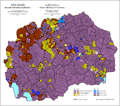 Ethnic structure of Macedonia by settlements 1961.
Ethnic structure of Macedonia by settlements 1961.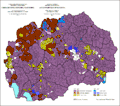 Ethnic structure of Macedonia by settlements 1971.
Ethnic structure of Macedonia by settlements 1971. Ethnic structure of Macedonia by settlements 1981.
Ethnic structure of Macedonia by settlements 1981. Ethnic map of the Republic of Macedonia, according to the 1981 census
Ethnic map of the Republic of Macedonia, according to the 1981 census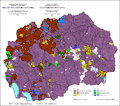 Ethnic structure of Macedonia by settlements 1991.
Ethnic structure of Macedonia by settlements 1991. Ethnic structure of Macedonia by settlements 1991.
Ethnic structure of Macedonia by settlements 1991. Ethnic structure of Macedonia by settlements 1994.
Ethnic structure of Macedonia by settlements 1994.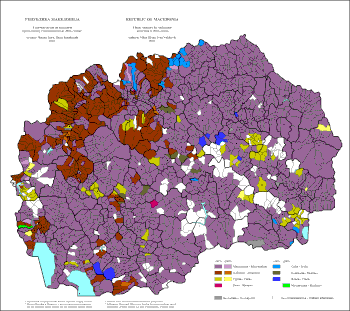 Ethnic structure of Macedonia by settlements 2002.
Ethnic structure of Macedonia by settlements 2002. Ethnic groups in the Republic of Macedonia, according to the 2002 census, on municipal level.
Ethnic groups in the Republic of Macedonia, according to the 2002 census, on municipal level..png) Ethnic groups in the Republic of Macedonia, according to the 2002 census
Ethnic groups in the Republic of Macedonia, according to the 2002 census Ethnic groups in the Republic of Macedonia, according to the 2002 census
Ethnic groups in the Republic of Macedonia, according to the 2002 census
| Ethnic group |
census 1948 | census 1953 | census 1961 | census 1971 | census 1981 | census 1991 | census 19941 | census 2002 | ||||||||
|---|---|---|---|---|---|---|---|---|---|---|---|---|---|---|---|---|
| Number | % | Number | % | Number | % | Number | % | Number | % | Number | % | Number | % | Number | % | |
| Macedonians | 789,648 | 68.5 | 860,699 | 66.0 | 1,000,854 | 71.2 | 1,142,375 | 69.3 | 1,281,195 | 67.0 | 1,328,187 | 65.3 | 1,295,964 | 66.6 | 1,297,981 | 64.2 |
| Albanians | 197,389 | 17.1 | 162,524 | 12.5 | 183,108 | 13.0 | 279,871 | 17.0 | 377,726 | 19.8 | 441,987 | 21.7 | 441,104 | 22.7 | 509,083 | 25.2 |
| Turks | 95,940 | 8.3 | 203,938 | 15.6 | 131,481 | 9.4 | 108,552 | 6.6 | 86,691 | 4.5 | 77,080 | 3.8 | 78,019 | 4.0 | 77,959 | 3.9 |
| Romani | 19,500 | 1.7 | 20,462 | 1.6 | 20,606 | 1.5 | 24,505 | 1.5 | 43,223 | 2.3 | 52,103 | 2.6 | 43,707 | 2.2 | 53,879 | 2.7 |
| Serbs | 29,721 | 2.6 | 35,112 | 2.7 | 42,728 | 3.0 | 46,465 | 2.8 | 44,613 | 2.3 | 42,775 | 2.1 | 40,228 | 2.1 | 35,939 | 1.8 |
| Bosniaks | 1,560 | 0.1 | 1,591 | 0.1 | 3,002 | 0.2 | 1,248 | 0.1 | 39,555 | 2.1 | 31,356 | 1.5 | 6,829 | 0.3 | 17,018 | 0.8 |
| Muslims | 15,418 | 0.8 | 2,553 | 0.1 | ||||||||||||
| Aromanians | 9,511 | 0.8 | 8,668 | 0.7 | 8,046 | 0.6 | 7,190 | 0.4 | 6,392 | 0.3 | 7,764 | 0.4 | 8,601 | 0.4 | 9,695 | 0.5 |
| Croats | 2,090 | 0.2 | 2,770 | 0.2 | 3,801 | 0.3 | 3,882 | 0.2 | 3,349 | 0.2 | 2,878 | 0.1 | 2,248 | 0.1 | 2.686 | 0.1 |
| Montenegrins | 2,348 | 0.2 | 2,526 | 0.2 | 3,414 | 0.2 | 3,246 | 0.2 | 3,940 | 0.2 | 3,225 | 0.1 | 2,318 | 0.1 | 2,003 | 0.1 |
| Bulgarians | 889 | 0.1 | 920 | 0.1 | 3,087 | 0.2 | 3,334 | 0.2 | 1,984 | 0.1 | 1,370 | 0.1 | 1,682 | 0.1 | 1.417 | 0.1 |
| Yugoslavs | 1,260 | 0.1 | 3,652 | 0.2 | 14,240 | 0.7 | ||||||||||
| other / unspecified | 4,390 | 0.4 | 5,304 | 0.4 | 4,616 | 0.3 | 22,988 | 1.4 | 6,228 | 0.3 | 45,239 | 2.2 | 9,814 | 0.5 | 14,8872 | 0.7 |
| Total | 1,152,986 | 1,304,514 | 1,406,003 | 1,647,308 | 1,909,136 | 2,033,964 | 1,945,932 | 2,022,547 | ||||||||
| 1 Since 1994 residents who were permanently living abroad were no longer included
2 Ashkali: 3,713 or 0.184%, Greeks: 422 or 0.021%, Russians: 368 or 0.018%, Slovenes: 365 or 0.018%, Poles: 162 or 0.008%, Ukrainians: 136 or 0.007%, Germans: 88 or 0.004%, Czechs: 60 or 0.005%, Slovaks: 60 or 0.005%, Jews: 53 or 0.003%, Italians: 46 or 0.002%, Austrians: 35 or 0.002%, Rusyns: 24 or 0.001%, Regionally affiliated: 829 or 0.041%, Non-declared: 404 or 0.02%, Others: 5332 or 0.264% | ||||||||||||||||
Languages
- Macedonian: 1 344 815 - 66.49%
- Albanian: 507 989 - 25.12%
- Turkish: 71 757 - 3.55%
- Romani: 38 528 - 1.90%
- Serbian: 24 773 - 1.22%
- Bosnian: 8560 - 0.42%
- Aromanian: 6 884 - 0.35%
- Other: 19 241 - 0.95%
- TOTAL: 2 022 547 - 100.00%
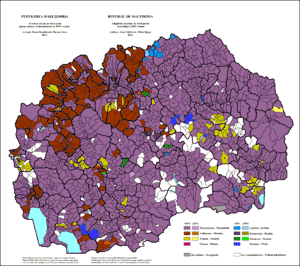 Linguistic structureв of Macedonia by settlements 2002.
Linguistic structureв of Macedonia by settlements 2002.
Religions
- Orthodox Christianity (Macedonian Orthodox Church): 1,300,000 or 61.6%
- Islam: 771,672 or 36.6%
- Catholicism (Macedonian Byzantine Catholic Church): 8,229 or 0.4%
- other: 28,801 or 1.4% (2010)[21][22]
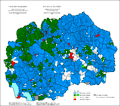 Religious structure of Macedonia by settlements 2002.
Religious structure of Macedonia by settlements 2002.
CIA World Factbook demographic statistics
The following demographic statistics are from the CIA World Factbook, unless otherwise indicated.
Age structure
- 0–14 years: 19.5% (male 210,078; female 203,106)
- 15–64 years: 67.8% (male 707,298; female 696,830)
- 65 years and over: 12.7% (male 97,437; female 124,661) (2004 est.)
Sex ratio
- at birth: 1.08 male(s)/female
- under 15 years: 1.08 male(s)/female
- 15–64 years: 1.02 male(s)/female
- 65 years and over: 0.78 male(s)/female
- total population: 1 male(s)/female (2004 est.)
Infant mortality rate
- total: 11.74 deaths/1,000 live births
- female: 10.73 deaths/1,000 live births (2004 est.)
- male: 12.67 deaths/1,000 live births
Life expectancy at birth
- total population: 74.73 years
- male: 72.45 years
- female: 77.2 years (2004 est.)
Total fertility rate
- 1.50 children born/woman (2015 est.)[14]
HIV/AIDS
- adult prevalence rate: less than 0.1% (2001 est.)
- people living with HIV/AIDS: less than 100 (1999 est.)
- deaths: less than 100 (2001 est.)
Nationality
- noun: Macedonian
- adjective: Macedonian
See also
References
- 1 2 3 "TFYR Macedonia Population". worldometers.info. Retrieved 2018-02-22.
- ↑ "Македонија со втора највисока смртност на новороденчиња во Европа" [Macedonia has the second highest infant mortality rate in Europe] (in Macedonian). Retrieved 2018-02-22.
- ↑ "Census of Population, Households and Dwellings in Macedonia 2002" (PDF). Stat.gov.mk. Retrieved 2017-08-29.
- ↑ "Macedonia Population Drained by Emigration, Report Says :: Balkan Insight". Balkaninsight.com. Retrieved 2017-08-29.
- ↑ "Fall in the number of population in FYROM". Balkaneu.com. Retrieved 2017-08-29.
- ↑ "Σκόπια: Σημαντική μείωση του πληθυσμού". Echedoros-a.gr. Retrieved 2017-08-29.
- ↑ "Божидар Димитров: 86.000 Македонци извадиле бугарски пасош". Web.archive.org. 11 January 2013. Retrieved 15 December 2017.
- ↑ "Димитров: 86.000 Македонци досега извадиле бугарски пасош". A1on.mk. 8 January 2013. Retrieved 2017-08-29.
- ↑ "Macedonia Govt Accused of Stalling Overdue Census : Balkan Insight". Balkaninsight.com. Retrieved 2017-08-29.
- ↑ "Institut national d'études démographique (INED)". Ined.fr. Retrieved 2017-08-29.
- ↑ "State Statistical Office Republic of Macedonia". Stat.gov.mk. Retrieved 2017-08-29.
- ↑ "03. Population" (PDF). Stat.gov.mk. Retrieved 2017-08-29.
- ↑ "MONTHLY STATISTICAL BULLETIN" (PDF). Stat.gov.mk. Retrieved 2017-08-29.
- 1 2 "Eurostat - Tables, Graphs and Maps Interface (TGM) table". ec.europa.eu. Retrieved 15 December 2017.
- ↑ "News release: Natural movement of population". Republic of Macedonia State Statistical Office. Retrieved 29 May 2017.
- ↑ "Archived copy". Archived from the original on 2007-09-28. Retrieved 2010-05-15.
- ↑ "Archived copy". Archived from the original on 2013-06-17. Retrieved 2013-06-14.
- ↑ "Statistical Yearbook of the Republic of Macedonia, 2016" (PDF). Stat.gov.mk. p. 77. Retrieved 10 December 2016.
- ↑ "Statistical Yearbook of the Republic of Macedonia, 2017" (PDF). Stat.gov.mk. p. 77. Retrieved 10 December 2017.
- ↑ "Archived copy". Archived from the original on 2011-03-09. Retrieved 2011-02-24.
- ↑ "Religious Composition by Country, 2010-2050". Pewforum.org. 2 April 2015. Retrieved 29 August 2017.
- ↑ "Religions in Republic Of Macedonia - PEW-GRF". Globalreligiousfutures.org. Retrieved 29 August 2017.
Other sources
- Statistical Yearbook of the Republic of Macedonia 2004 (CD version)
External links
| Wikimedia Commons has media related to Demographics of the Republic of Macedonia. |
